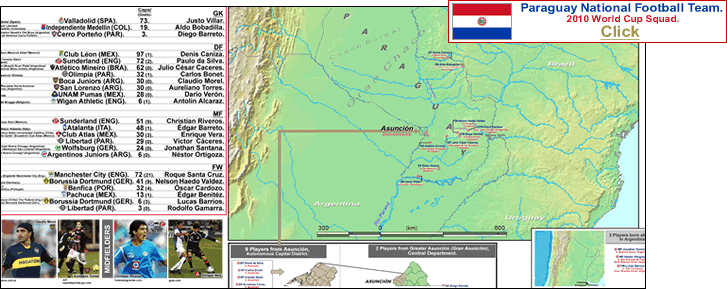
Paraguay World Cup squad.
The map shows the birthplaces of the players on the Paraguay national football team which competed in the 2010 World Cup in South Africa.
At the bottom, left of the map page are all the players on the Paraguay team who saw action in Paraguay’s 5 matches in the 2010 World Cup (20 player photos, all in the gear of the players’ professional clubs). International appearances (aka caps) and international goals are up to date as of 3rd July, 2010 (that is, after Paraguay exited the 2010 World Cup in the Quarterfinals).
-
Asunción is the capital and only large city in Paraguay, with a city population of around 680,000, and a metro-area population of around 1.87 million {2009 figures}. Paraguay itself has a population of around 6.3 million. Paraguay is one of only two land-locked nations in South America (the other being Bolivia).
The most important geographic characteristic of Paraguay is the contrast between the two major regions in the country, Oriental Paraguay and Occidental Paraguay (ie, East and West Paraguay). The two regions are divided by the Rio Paraguay, which is a tributary of the mighty Rio Paraná (which empties into the Atlantic between Argentina and Uruguay). Western Paraguay is a dry and barren region that is part of the Gran Chaco, which stretches from north-central Argentina, through western Paraguay and into Bolivia and a small section of Brazil. Over 90% of Paraguayans live in the eastern half of the country, which is also called the Paraneña region. The eastern half of Paraguay boasts fertile land and agriculture dominates the economy and it’s total exports (soybearn production and exports have skyrocketed in recent years). Yet to this day, thousands of Paraguayans still rely on subsistence farming to survive. Urban unemployment has always been a problem in Paraguay.
But what the country has going for it is vast hydroelectric power reserves. Paraguay relies almost entirely on hydroelectric power, and exports large quantities. Paraguay is the world’s second-largest exporter of electricity {France is first, see this list}. The Itaipú Dam, just upstream from the spectacular Iguazu Falls, is jointly run with Brazil, and has the world’s second-largest generating capacity. Another dam in the south of Paraguay (the Yacyretá) is jointly run with Argentina. These two dams’ and the Iguazu Falls’ locations are shown on the map.
…
Paraguay is a bilingual country…it’s two official languages are Spanish and Guaraní. [The Guaraní were the indigenous peoples that lived in the regions now known as Paraguay and also parts of southern Brazil, Bolivia, and Argentina.] Around 95% of Paraguayans are of mestizo (or mixed) race, the majority being a mix between European and Guaraní. An interesting fact is that the Paraguay national football team takes advantage of this, when playing other Spanish-speaking teams…during matches they speak to each other in Guaraní so their opponents don’t pick up their strategy.
-
20 players in the Paraguay squad were born in Eastern Paraguay, and zero players were born in the Chaco. 3 players were born in Argentina, including two who have seen action in the 2010 World Cup…FW Jonathan Santana (who plays professionally for Wolfsburg, the 2009 German champion), and FW Lucas Barrios (who scored 19 goals for German club Borussia Dortmund in 2009-10). [The Paraguay coach, Gerado Martino, is also an Argentine.]
…
9 players were born in the city of Asunción, including talismanic striker Roque Santa Cruz (of Manchester City), with 2 more players coming from Greater Asunción (Gran Asunción), including midfieder and playmaker Christian Riveros (who was signed by Sunderland in May, 2010).
Other Asunción-born players who have started, or seen action, in the 2010 World Cup are… DF Paulo da Silva (also of Sunderland), DF Claudio Morel (of Argentine giants Boca Juniors), DF Aureliano Torres (who also plays in Argentina, for San Lorenzo), MF Édgar Barreto (of Italian top-flight minnows Atalanta), MF Enrique Vera (of Club Atlas of Guadalajara, Mexico), MF Victor Cáceres (who plays for Paraguayan giants Libertad), and another player who plays professionally in Paraguay: DF Carlos Bonet, who plys his trade with the most sucessful Paragauyan football club, Olimpia (who have won the most Paraguayan titles, 38, as well as 3 Copa Libertadores titles, the last in 2002).
…
4 players were born in Caaguazú Department (I highlighted Caaguazú Department in pale white on the map). All four of these Caaguazú-born players have either started or seen action in the 2010 World Cup…FW Nelson Haedo Valdez (who also plays for Borussia Dortmund), FW Óscar Cardozo (who plays in Portugal for Benfica), FW Édgar Benitez (who plays for the internationally successful Mexican club Pachuca), and DF Júlio César Cacerés (who is signed with Brazil’s Atlético Mineiro).
…
2 players were born in Amambay Department, which is in north-central Paraguay and borders Brazil, including DF Denis Caniza, who is the most-capped player and team captain. Caniza now plays for Club Léon, a second division Mexican club.
…
3 players come from departments south of Asunción. One of these players is a starter, GK Justo Villar (of just-relegated Spanish club Valladolid). Villar was born in Cerrito, Ñeembucú Department, which is on the Rio Paraña, just downstream from the Yacyretá Dam, and on the border with Argentina. DF Antolín Alcaraz, born in San Roque Gonzalez, Paraguarí Department, saw action in 3 matches; in May, 2010, Alcaraz was sold by the Belgian Club Brugge to England’s Wigan Athletic. DF Dario Verón, born in San Ignacío, Misiones Department, saw action in Paraguay’s final match, versus Spain. Verón plays for Mexoico’s Pumas de UNAM.
-
Thanks to the contributors to the pages at en.wikipedia.org, Paraguay national football team.
Thanks to Big Soccer.com, for the photos of the Paraguay jerseys.
Thanks to Demis.nl, for the Paraguay base map, Demis Web Map Server.
